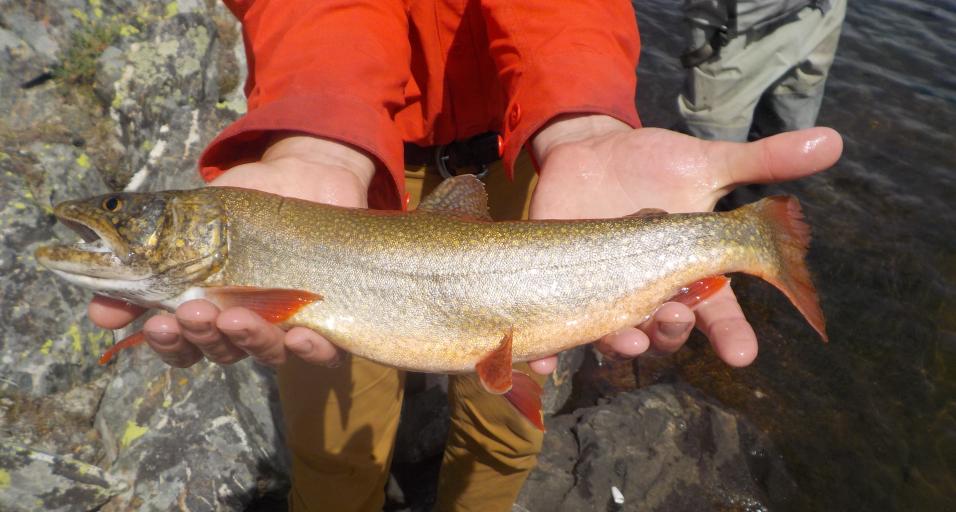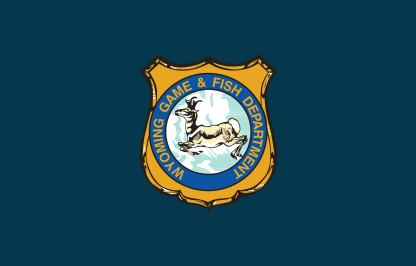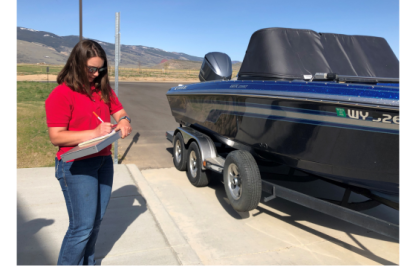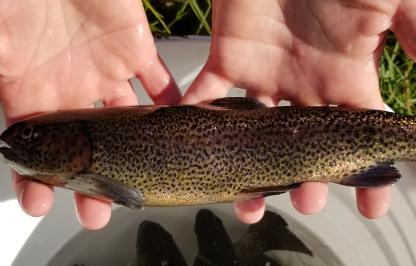The Wyoming Game and Fish Department in cooperation with the U.S. Forest Service conducted a survey within the Dinwoody Creek drainage of the Wind River Mountains from July 14 – 21, 2020. Surveyed lakes and streams are approximately 10 to 15 miles from the Glacier Trailhead near Dubois and are located within the Fitzpatrick Wilderness of the Shoshone National Forest. The Dinwoody drainage was last surveyed in 2007, and before that in 1990. All but one of the fish populations within the drainage are self-sustaining. Cutthroat trout (both the Snake River and Yellowstone subspecies) are the primary sport fish within the Dinwoody Creek drainage, although brook trout, golden trout and splake (a hybrid between a male brook trout and a female lake trout) also exist.
Survey results from Upper Phillips and Phillips lakes were discouraging. Although native Yellowstone cutthroat trout and nonnative lake trout (which were stocked in 1975 to control an overabundance of longnose suckers) were captured in past surveys, neither species was observed in 2020. Both lakes contained an overabundance of longnose suckers, and a single brook trout was captured in Phillips Lake. 
.jpeg)
Golden Lake is the only lake within the Dinwoody drainage that is currently managed by stocking, and the only lake that contains golden trout. Golden Lake has a similar history to many stocked golden trout lakes throughout Wyoming. A quality fishery was maintained through periodic stocking from 1958 – 1992 using eggs obtained at Surprise Lake near Pinedale. After a wildfire decimated the golden trout population at Surprise Lake, stocking ceased until 2010, leaving Golden Lake fishless for almost two decades. Stocking ceased because no suitable wild brood sources could be found, and golden trout are notoriously difficult to raise in hatcheries. Through a lot of time, effort, and expertise, fish culture personnel at the were successful at creating the current captive brood source at Story Hatchery, and stocking resumed in 2010. Although stocking occurred at Golden Lake in 2010, 2012, 2014, and 2018, sampling in 2020 indicated few if any golden trout from the 2010 – 2014 stocking events are still alive. Golden trout captured in 2020 ranged from 7.0 to 11.0 inches in length, indicating most of the population is composed of fish from the 2018 stocking event.
Survey results for Star Lake were outstanding for both numbers and size of sport fish. Splake were first stocked in Star Lake in 1958, have maintained a naturally-reproducing population since. Sampling this year showed an excellent sport fishery still exists, with high numbers of splake from 14.9 - 16.8 inches.
Honeymoon Lake contained the highest numbers of Yellowstone cutthroat trout of any surveyed lake, with lengths ranging from 7.9 to 12.6 inches. Double Lake contained lower numbers of Yellowstone cutthroat trout, but good numbers of brook trout and splake. It is unknown if the Yellowstone cutthroat trout in Honeymoon and Double lakes are the result of undocumented stocking, or if the fish are indigenous. Genetic samples (i.e., small fin clips) were obtained from captured fish to determine their source. The results will likely be available in a few years after completion of a cooperative study between the Game and Fish and the University of Wyoming assessing Yellowstone cutthroat trout genetics throughout Wyoming.
Snake River cutthroat trout were common in Blueberry and Twin lakes, which are located on Downs Fork Creek and are the farthest lakes from the trailhead that contain fish. The Snake River cutthroat trout were originally stocked in 1971, and have been sustained through natural reproduction ever since.
Fish populations in Dinwoody and Downs Fork creeks within Downs Fork Meadows, and Dinwoody Creek within Shangrila Meadows were also surveyed. Snake River and Yellowstone cutthroat trout were captured in both streams within Downs Fork Meadows. Both cutthroat trout species and brook trout were captured or observed in Dinwoody Creek within Shangrila Meadows. A waterfall on Dinwoody Creek prevents nonnative brook trout from moving upstream from Shangrila to Downs Fork meadows, which is beneficial for the long-term persistence of native cutthroat trout within the drainage.
| Water | Species | Length Range (inches) |
|---|---|---|
| Golden Lake | Golden Trout | 7.0 - 11.0 |
| Upper Phillips Lake | Longnose Suckers | 9.1 - 17.3 |
| Phillips Lake | Brook Trout Longnose Suckers | 10.1 (1 fish) 8.0 - 15.5 |
| Double Lake | Broook Trout Splake Yellowstone Cutthroat Trout | 9.0 - 13.6 9.7 - 13.2 8.8 - 11.4 |
| Star Lake | Splake | 14.9 - 16.8 |
| Honeymoon Lake | Yellowstone Cutthroat Trout | 7.9 - 12.6 |
| Blueberry lake | Snake River Cutthroat Trout | 7.0 - 17.3 |
| Twin Lake | Snake River Cutthroat Trout | 8.2 - 15.5 |
| Dinwoody/Downs Fork Creeks | Snake River Cutthroat Trout | 6.5 - 14.1 |
| In Downs Fork Meadows | Yellowstone Cutthroat Trout | 9.6 - 14.0 |
| Dinwoody Creek in Shangrila Meadows* | Brook Trout Yellowstone Cutthroat Trout | 7.0 - 12.0 11.0 - 13.3 |
*Snake River cutthroat trout also exist in Dinwoody Creek throughout Shangrila Meadows, but were not captured during the 2020 survey. Setting nets on Twin lake
Setting nets on Twin lake.jpg?width=350&height=262) Cutthroat Trout from the survey
Cutthroat Trout from the survey Sunset on Star Lake
Sunset on Star Lake




